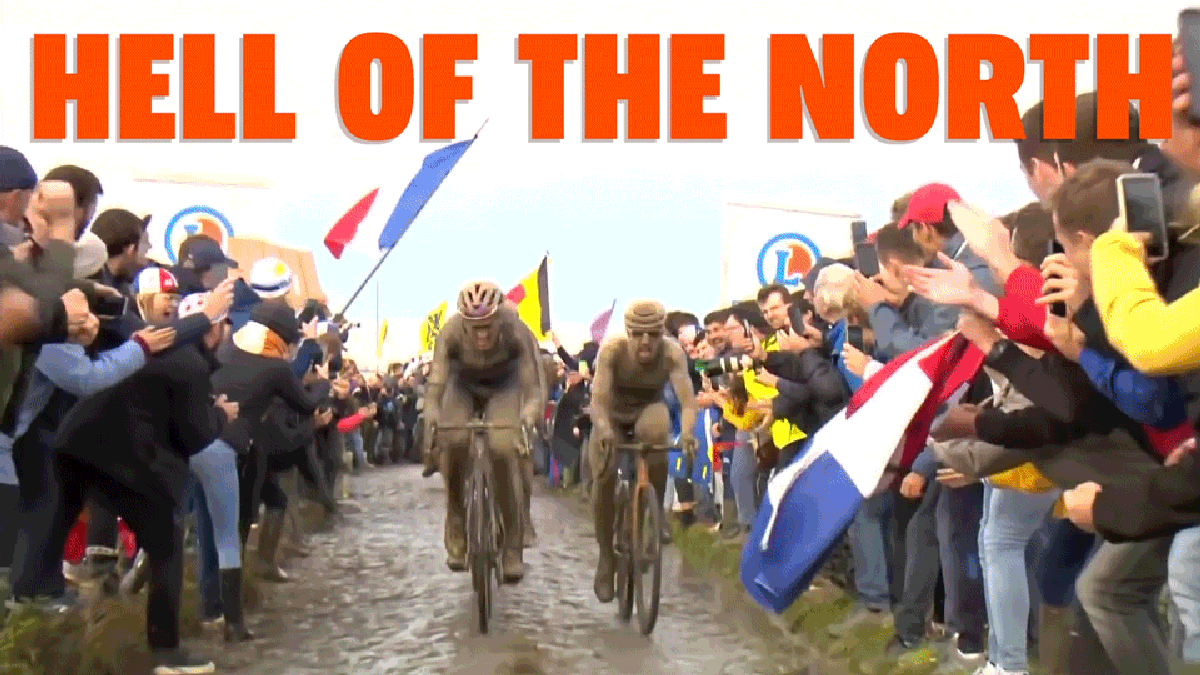A Ride Through Hell: Why You Should Watch The Paris-Roubaix

Gif: Amaury Sport Organisation
With most of Europe’s major motorsport championships not competing this weekend, fans of Formula 1 and MotoGP have some free time over the next two days. Sure, they could wait until later in the day to watch the NASCAR Cup Series race on the dirt-covered banks of Bristol Motor Speedway for the second time. But, I have a better option. They should watch the world’s best cyclists endure northern France’s narrow dust-covered cobblestone roads in the Paris-Roubaix.
Even if you’re entirely unfamiliar with professional cycling, you still likely recognize the name of its greatest race, the Tour de France. It’s how I became interested in road cycling as a kid. The Tour features 21 days of racing over a 24-day period, where riders have to climb the equivalent of over five Everests in terms of elevation. Though, I wouldn’t recommend watching the Tour de France as a first-time viewer. A three-week race just isn’t approachable.
The Paris-Roubaix is the opposite of the Tour. The 160-mile course is completely flat and features no mountain climbs. It’s run over a single day. It usually takes the winner about six hours to complete the race. It might sound easy on paper, but it’s one of the most coveted races to win for any professional cyclist.
The Paris-Roubaix is a Monument, the title given to the five most prestigious one-day races on the cycling calendar. Some of its prestige is due to age. The race was first held in 1896. This weekend’s race will be the 119th edition of the Paris-Roubaix. Though, most of its prestige is due to the course’s difficulty.
A rainy Paris-Roubaix means getting covered in mud via tire spray or fallsPhoto: David Stockman/Belga Mag/AFP (Getty Images)
G/O Media may get a commission
Pavé Maria
Why is the Paris-Roubaix difficult? Dust and cobbles, mainly cobbles. Between the race’s start and Roubaix, the course takes riders over 30 sectors of pavé (cobbles), 34 miles on the stones in total. The cobbles shake bicycle frames and rattle riders. Teams often fit their bikes with wider tires and run with lower tire pressures to prevent punctures. This also allows the tires to act as a makeshift suspension to lessen the physical strain on the riders. Though, it isn’t enough for riders. They double-tape their handlebars and even tape their pedals to dampen the vibrations and lessen the chances of their extremities going numb. The race’s grueling and punishing nature gives the event its nickname, the Hell of the North.
Each of the 30 cobbled sectors is named and categorized on a scale of one to five stars, with five being the most difficult. The sectors are graded based on length, roughness, condition and route location. The route currently has three five-star sectors. Though, the Paris-Roubaix’s two most iconic five-star sectors are the Trouée d’Arenberg and the Carrefour de l’Arbre.
Trouée d’Arenberg
The Trouée d’Arenberg translates into English as the Arenberg Trench, but the sector is more commonly referred to as the Arenberg Forest. It’s a narrow straight 1.4-mile stretch of cobblestone road hemmed in on both sides by forest and passionate spectators. It might sound counterintuitive, but riders want to get over the cobbles as quickly as possible. The faster you go, the smoother the ride is as you skim over the top of the stones. And the high speeds encouraged by such a long and rough straight leads to big crashes and mechanical failures.
Carrefour de l’Arbre
The Carrefour de l’Arbre, or simply the Carrefour, begins with around 10.5 miles to go in the race and is the last five-star cobbled sector on the course. Because of the corners at Carrefour’s start and how close it is to the finish, leading riders use this sector as an opportunity to attack and break away from the field before the finish. If raining, the cobbles are slippery and caked in mud. The riders are usually covered in mud by this point, like in the 2021 race. Even if dry, the cobbles are dusty and don’t offer much more traction.
While the cobbled sectors are the race’s defining feature, race organizers or local authorities don’t maintain most of these public roads. Les Amis de Paris–Roubaix (the Friends of Paris-Roubaix), a volunteer group, has maintained and repaired the pavé for almost 40 years. The group also provides the trophies for the race, heavy granite cobblestones.
The Closing Bell
The Paris-Roubaix concludes with a lap and a half on the outdoor Roubaix Velodrome. While the smooth concrete oval might be a welcome respite after such a grueling ride, the first rider often doesn’t enter the velodrome alone. The winner usually has to beat at least one other rider in a sprint to the finish.
During the 2021 race, favorite Mathieu van der Poel entered the velodrome first with Sonny Colbrelli and Florian Vermeersch right behind him. Vermeersch was the first to attack with roughly 250 yards to go, Colbrelli won the race and Van der Poel ended up finishing third. And yes, the riders do get to rinse off before the podium ceremony.
Lizzie Deignan (center) holding her trophy, a big granite cobblestoneGraphic: Eric Lalmand/Belga Mag/AFP (Getty Images)
2021 also saw the first-ever Women’s Paris-Roubaix in the event’s 125-year history. While the 72-mile route of the Paris-Roubaix Femmes was shorter than the men’s races, it still had the same final 17 cobbled sectors, including the Carrefour. Britain’s Lizzie Deignan won the race after carefully managing a solo breakaway she launched on the first cobbled section, 37 miles from the finish.
If you live in the United States, you can watch both races on NBC’s streaming service Peacock, with the women’s race on today and the men’s race tomorrow on Sunday.







